Different Water Design Options
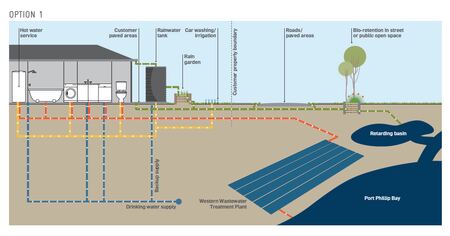
The example of Melbourne’s Northern Growth Corridor
Integrated water cycle management is a multi-disciplinary and multi-objective approach, used to promote the sustainable use of all available water resources in ways that best deliver multiple community objectives.
Compared to a traditional servicing approach, the adoption of integrated water cycle management solutions can deliver higher community value by optimising the benefits and costs of each investment in water cycle management – resulting in improved drinking water security, better waterway health outcomes, improved urban amenity and reduced risk of localised flooding.
Options investigated can be categorised into one of the following three groups:
- Traditional option: represents the 'default future'.
- Recycled water option: an improvement on the traditional option.
- Integrated options: are purposely engineered to tackle the issues associated with stormwater runoff volume and frequency. These options represent the 'preferred future' in which water cycle services are designed to take account of all the impacts they have on the environment.
Here, an example by Yarra Valley Water and Melbourne Water that investigates sustainable ways to provide water supply and sanitation services to new homes and businesses in Melbourne’s Northern Growth Corridor in 2013 will present regarding the above three divisions.
OPTION 1 – Integrated option: HOUSEHOLD RAINWATER HARVESTING
Rainwater tanks are installed at each residential house to collect water that falls from the roof. The water is reused to flush toilets, wash clothes and water the garden. Any collected rainwater that is not reused is passed through an onsite rain garden, which only overflows into the piped drainage system during large rainfall events.
Larger bio-retention systems (which include swales, infiltration basins, and street tree beds) and wetlands are located throughout the piped drainage system, effectively disconnecting it from directly discharging into the receiving waterway.
Piped drinking water supply and sanitation services are provided. The drinking water pipes cannot be downsized, as they need to be able to supply the total water demand for each house in the event that the rainwater tanks are empty.
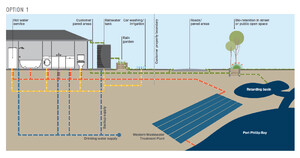
OPTION 2 – Recycled water option: REGIONAL WASTEWATER RECYCLING
Wastewater is collected and treated to recycled water standard at a regional treatment facility.
The recycled water is then returned to residential houses via a ‘third pipe’ system for non-drinking purposes such as flushing toilets, washing clothes and watering the garden.
Piped drinking water supply and sanitation services are provided; however, drinking water pipes can be downsized as approximately 30 per cent of the water demand will be met by the recycled water system. Rainwater and stormwater are collected in pipes and treated through a series of settling ponds and wetlands prior to discharge into the receiving waterway. Please note, this option is not considered to be integrated as it does not address stormwater runoff volume and frequency reduction.
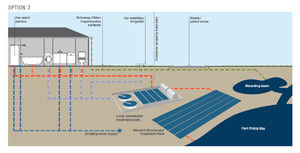
OPTION 3 – Integrated option: REGIONAL WASTEWATER RECYCLING WITH DRAINAGE SYSTEM DISCONNECTION
As per Option 1 minus rainwater tanks is required. To compensate for the loss of rainwater harvested, an increased amount of large bio-retention systems are required throughout the catchment to ensure the piped drainage system remains disconnected from the receiving waterway.
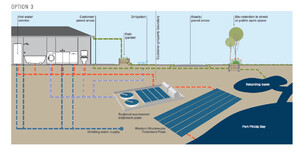
OPTION 4 – Integrated option: REGIONAL WASTEWATER RECYCLING COMPLEMENTED BY HOUSEHOLD RAINWATER HARVESTING
A hybrid of Options 1 and 3; however, in this instance, recycled water is used for flushing toilets, washing clothes and outdoor uses, while rainwater is used to supply the hot water service.
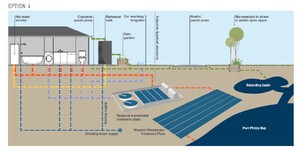
OPTION 5 – traditional option: A TRADITIONAL APPROACH WITH A 5 STAR HOMES UPDATE
Piped drinking water supply and sanitation services are provided, through connection to existing centralised infrastructure. Rainwater and stormwater is collected in pipes and treated through a series of settling ponds and wetlands prior to discharge into the receiving waterway.
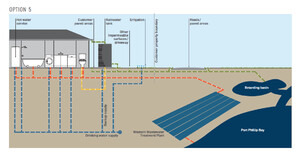
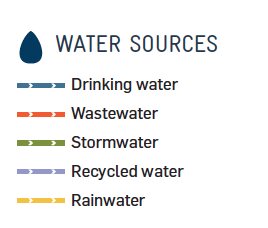
Finally, a comparison matrix of the above five options.
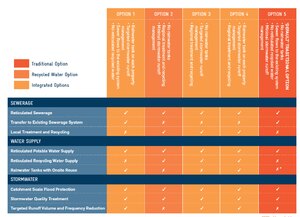
http://www.yvw.com.au/yvw/groups/public/documents/document/yvw1003862.pdf

